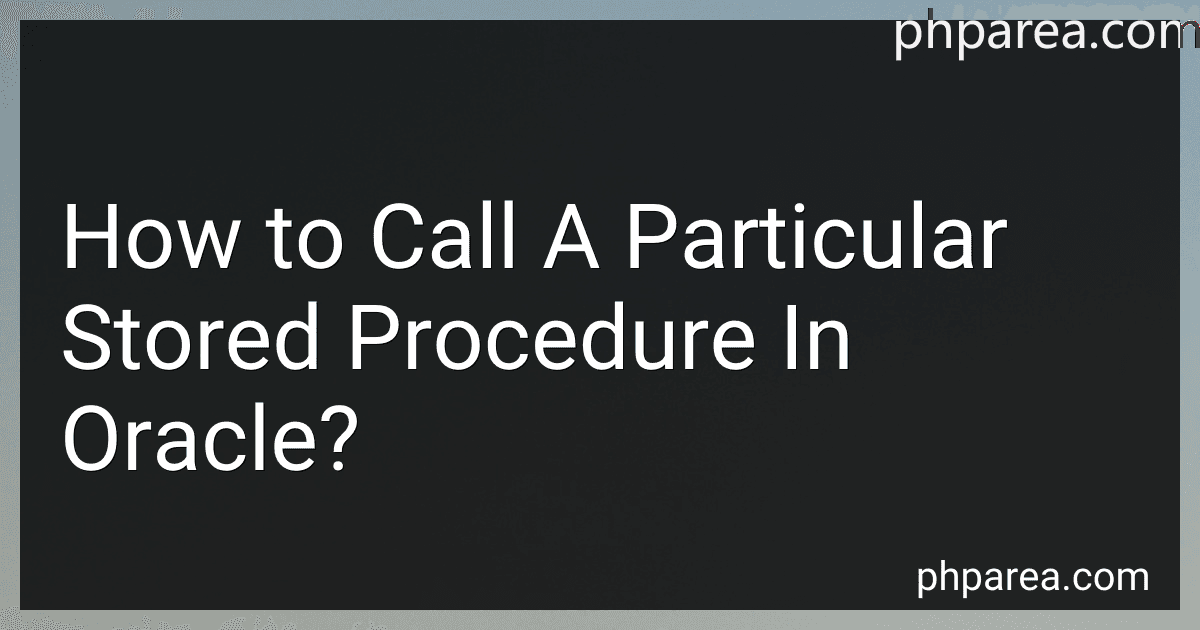Best Database Management Tools to Buy in November 2025

Database Systems: Design, Implementation, & Management


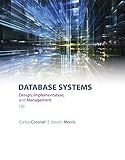
Database Systems: Design, Implementation, & Management


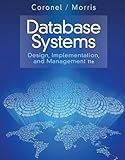
Database Systems: Design, Implementation, & Management


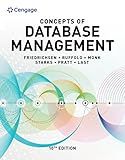
Concepts of Database Management (MindTap Course List)



Statistics: A Tool for Social Research and Data Analysis (MindTap Course List)



Bioinformatics for Beginners: Genes, Genomes, Molecular Evolution, Databases and Analytical Tools



Data Mining: Practical Machine Learning Tools and Techniques (Morgan Kaufmann Series in Data Management Systems)
- EXCLUSIVE LAUNCH: BE THE FIRST TO EXPERIENCE OUR LATEST INNOVATION!
- LIMITED TIME OFFER: GRAB YOUR 'NEW' PRODUCT AT A SPECIAL PRICE!
- ENHANCED PERFORMANCE: DISCOVER CUTTING-EDGE FEATURES THAT WOW!



The Manga Guide to Databases (The Manga Guides)


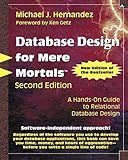
Database Design for Mere Mortals: A Hands-On Guide to Relational Database Design


To call a particular stored procedure in Oracle, you can use the following syntax:
- Start by opening the SQL*Plus application or any other Oracle client tool.
- Connect to your Oracle database using the appropriate credentials.
- Once connected, you can call the stored procedure using the EXECUTE or EXEC command, followed by the stored procedure name and any required parameters.
For example, if you have a stored procedure named "my_procedure" that takes two parameters, you would call it as follows:
EXEC my_procedure(parameter1, parameter2);
Replace "my_procedure" with the actual name of your stored procedure and provide the required parameters, if any.
- If the stored procedure does not require any parameters, simply call it without any arguments:
EXEC my_procedure;
Ensure that you have the necessary privileges to execute the stored procedure. If you encounter any errors or issues, check the stored procedure's definition, parameters, and any relevant documentation for guidance.
How to schedule a stored procedure to run at specific intervals in Oracle?
To schedule a stored procedure to run at specific intervals in Oracle, you can use the Oracle DBMS_SCHEDULER package. Here are the steps:
- Create a new job using the CREATE_JOB procedure in the DBMS_SCHEDULER package. Provide a unique job name and specify the stored procedure you want to schedule.
BEGIN DBMS_SCHEDULER.CREATE_JOB ( job_name => 'YOUR_JOB_NAME', job_type => 'STORED_PROCEDURE', job_action => 'YOUR_STORED_PROCEDURE_NAME', start_date => SYSTIMESTAMP, repeat_interval => 'FREQ=DAILY; INTERVAL=1', enabled => TRUE); END; /
- In the above code, the 'start_date' parameter determines the initial execution time of the job. You can modify it to your preferred start time.
- The 'repeat_interval' parameter defines the frequency and interval at which the job will run. You can customize this parameter according to your requirements. For example, 'FREQ=DAILY; INTERVAL=1' means the job will run daily.
- The 'enabled' parameter is set to TRUE to enable the job. If you want to disable the job temporarily, you can set it to FALSE.
- Once the job is created, it will run according to the specified schedule. You can monitor the job and its execution using various views provided by the DBMS_SCHEDULER package, such as DBA_SCHEDULER_JOBS or USER_SCHEDULER_JOBS.
Note: You may need appropriate privileges (such as CREATE JOB) to execute the above code. Additionally, make sure that the stored procedure you want to schedule is already created and exists in the database.
How to create a stored procedure with default parameters in Oracle?
To create a stored procedure with default parameters in Oracle, you can follow these steps:
- Open an SQL tool such as SQL Developer or SQL*Plus.
- Connect to your Oracle database.
- Execute the following SQL statement to create a stored procedure:
CREATE OR REPLACE PROCEDURE procedure_name ( parameter1 datatype DEFAULT default_value, parameter2 datatype DEFAULT default_value, ... ) AS BEGIN -- procedure body END;
Replace procedure_name with the desired name for your stored procedure. Define the parameters inside the parentheses, each with its data type and default value using the DEFAULT keyword.
- Write the logic or actions you want the stored procedure to perform inside the BEGIN and END blocks. You can use the provided parameters within the procedure's body as needed.
- Save and execute the SQL statement to create the stored procedure.
Once the procedure is created, you can call it with or without passing values for the parameters. If a parameter value is not explicitly provided during the procedure call, the default value specified in the procedure definition will be used.
What is the difference between a stored procedure and an anonymous block in Oracle?
In Oracle, a stored procedure and an anonymous block are both types of PL/SQL code that can be executed on the database server. However, there are some key differences between the two:
- Compilation and Execution: A stored procedure is a named and compiled PL/SQL code object stored in the database. It is compiled once and can be executed multiple times by calling its name. On the other hand, an anonymous block is a temporary and uncompiled code block that is executed immediately after it is defined. It is not stored in the database and does not have a name.
- Reusability: Stored procedures are reusable code objects that can be called and executed by multiple users and applications. They can be invoked from any application that has access to them. In contrast, anonymous blocks are typically used for one-time execution and are not reusable.
- Maintainability: As stored procedures are stored in the database, they can be easily maintained, updated, and version-controlled. Any changes made to a stored procedure are immediately available to all applications that call it. On the other hand, anonymous blocks are defined directly in the code where they are executed, making them harder to maintain and update.
- Privileges and Security: Stored procedures have their own permissions and privileges, allowing fine-grained control over who can execute them and access the underlying database objects. Anonymous blocks inherit the privileges of the user executing them, which may not provide the same level of control and security.
- Exception Handling: Stored procedures can include exception handling blocks to handle errors and exceptions that occur during their execution. Anonymous blocks can also handle exceptions, but since they are usually smaller and one-time executions, they may not have robust exception handling.
Overall, stored procedures provide a more structured and reusable approach to executing PL/SQL code, while anonymous blocks are useful for ad-hoc or one-time execution of code.
How to check if a stored procedure exists in Oracle?
To check if a stored procedure exists in Oracle, you can use the following query:
SELECT object_name FROM all_objects WHERE object_type = 'PROCEDURE' AND object_name = 'your_procedure_name';
Replace 'your_procedure_name' with the name of the stored procedure you want to check. If the stored procedure exists, the query will return the name of the procedure; otherwise, it will return no rows.
How to call a stored procedure from a trigger in Oracle?
To call a stored procedure from a trigger in Oracle, you can use the EXECUTE statement. Here's an example of how you can do it:
- Create the stored procedure:
CREATE OR REPLACE PROCEDURE my_procedure AS BEGIN -- Your procedure logic goes here NULL; END;
- Create the trigger and call the stored procedure within it:
CREATE OR REPLACE TRIGGER my_trigger AFTER INSERT ON my_table FOR EACH ROW BEGIN EXECUTE my_procedure; END;
In this example, the trigger my_trigger will be executed after an INSERT operation on the my_table table. It will then call the my_procedure stored procedure using the EXECUTE statement.
What is the maximum number of parameters allowed in a stored procedure in Oracle?
In Oracle, the maximum number of parameters allowed in a stored procedure is 32767.
